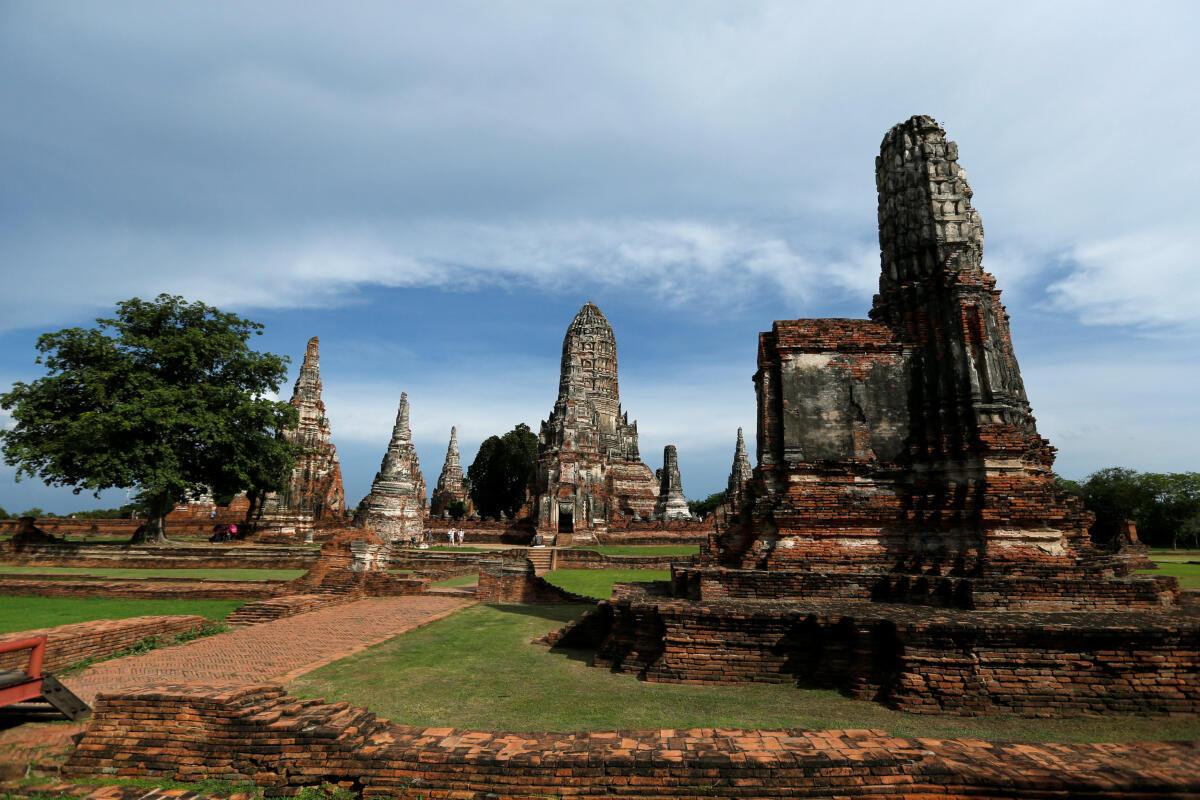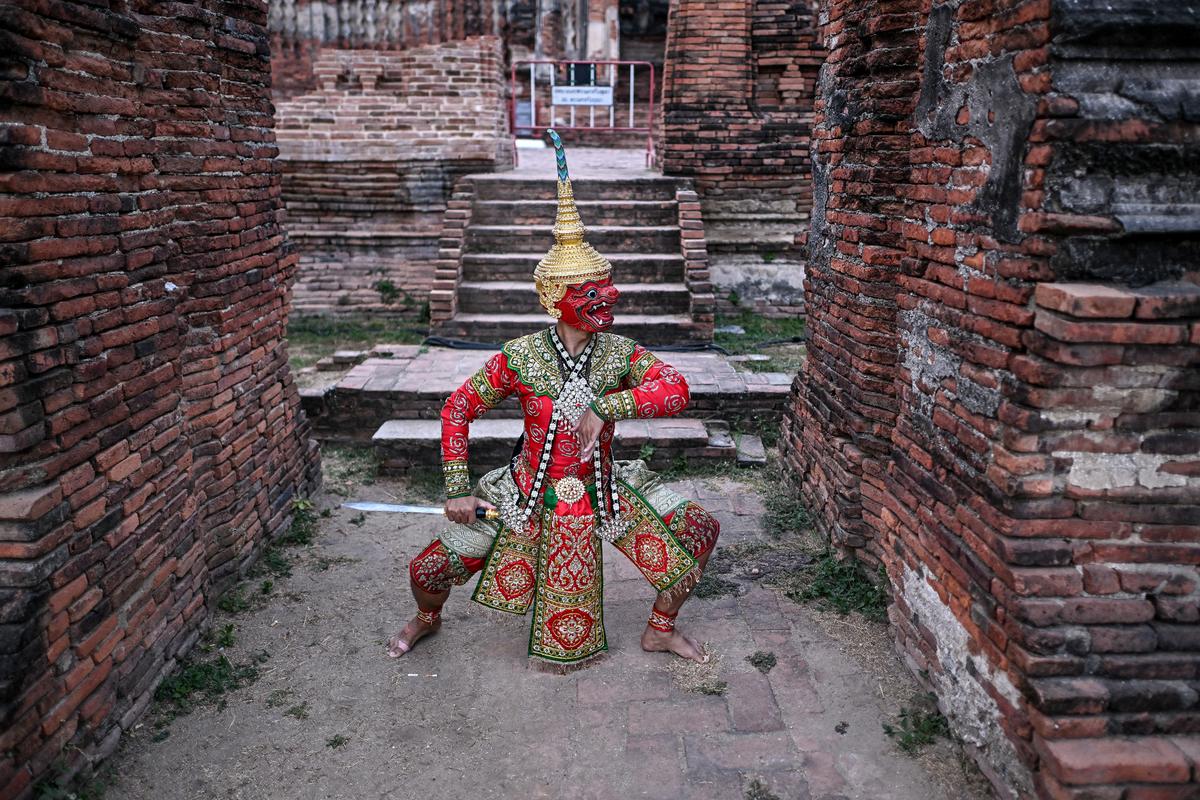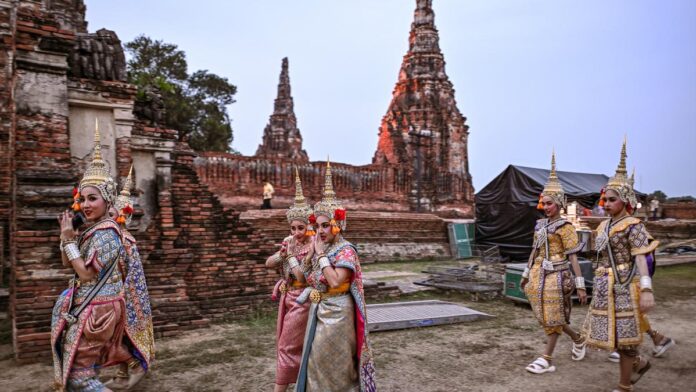
Thai artists get ready for Khon, a theatrical dance performance that showcases the story of the Ramayana, at Wat Chaiwatthanaram temple in Ayutthaya.
| Photo Credit: Getty Images
In Thailand, there is another Ayodhya, known locally as Ayutthaya. It is a ruin now, full of tall pagodas and temples made of brick and stucco, and hundreds of images of the Buddha, many headless. This was the capital of Thai kings for four centuries, before it was sacked by the Burmese in the 18th century.
The Ram of this Ayodhya was the king, addressed as Ramathibodhi (Overlord Rama), as the royal name is not to be spoken. We realise the impact of the Ramayana in Thai society even today when we learn that there are strict laws preventing people from criticising the royal family. It was public gossip after all that forced Ram to abandon his wife Sita, in the Treta Yuga.
The word ‘Thai’ means free. Originally the Thai people were the ‘Tai’ people who migrated from Southern China to Southeast Asia, around a thousand years ago. Incidentally, another group of Tai people migrated to Assam, in India, and were the ancestors of the Ahom kings.
Tai saw their king as a semi-divine figure, like Chinese emperors, connecting heaven and earth. They introduced their very peculiar model of taxation — through labour, working on royal projects, such as building canals and temples and palaces. This is how the great temple cities of Southeast Asia were built, a physical manifestation of royal taxes, expressing royal glory.
Ramayana, Ramakien and other iterations
Most kings of Southeast Asia followed the Mandala or the ‘circle-of-king’ model of governance. This is described in Chanakya’s Artha-shastra, and Manu’s Dharma-shastra. Here, a king’s influence is not fixed; it expands and contracts depending on their charisma and capability. As he moves out of his capital there are lands where he collects rent from, lands he collects taxes from, lands he collects tribute from. Then come hostile lands of enemies, followed by lands of the enemies of his enemies, and thus his friends — with whom he exchanges gifts, waiting for the right opportunity to plunder the city of their common enemy.

Ruins of the ancient city of Ayutthaya
Most of these Mandala kingdoms were part of a trading network, located on the banks of rivers. Merchant ships sailed up and down the river, along the coast, and across the seas connecting Southeast Asia to China in the east and India in the west. We find such river-bank Mandala kingdoms along Burma’s Irrawaddy and Cambodia’s Mekong, too. Ayutthaya was located at the confluence of three rivers, which contributed to its mercantile wealth.
These cities were famous for their irrigation systems, vast rice fields and grand temple complexes. They were initially influenced by Pashupata Hinduism and Mahayana Buddhism, and later, after the 10th century, by a rejuvenated Theravada Buddhism that radiated out of Sri Lanka. Also connecting these circular kingdoms was the epic of Ram, the Ramayana, retold by shadow puppeteers and court dancers.
Buddhist, Jain and even folk versions of the Ramayana reached Southeast Asia via sea-faring merchants over 1,500 years ago. This so inspired the local kings that they had them carved on the walls of the grand monuments they built, such as the 9th century Prambanan temple on the island of Jawa, Indonesia, and on the walls of the 12th century Angkor Wat temple in Cambodia.
The Thai version is known as the Ramakien. Anyone who watches this performance will notice that while the story is very familiar, it lacks bhakti — an emotion that shapes Hinduism today. Bhakti rose in South India much later, around the time of the Chola kings, whose imperial ambitions led them to war against the Srivijaya kings of Indonesia. In fact, as per one lore, the founder of Ayutthaya, Uthong, was a Chola soldier who married a Tai princess. Another insists he was Chinese.

An artiste before the start Khon
| Photo Credit:
Getty Images
The reach of Rama
The Tai kings were influenced by the Buddhism of Burmese kings and the Hinduism of Cambodian kings. So, the Thai polity is a mix of both ideas. Ram of Thailand, as in Cambodia, is a Bodhisattva. The Thai kings sought to be as regal as Ram and so built Ayutthaya to match his royal splendour. Royal court performances of the Ramayana reinforced their power, as did the Buddhist pagodas and temples, housing relics of royal family members and religious leaders.
But when this royal city was sacked, its treasures burnt, in 1765, it was history repeating itself. This had happened to their earlier capital of Sukhothai further north, prompting the shift to Ayutthaya. Now, it was time to move further south, where a new city would be established, on the banks of the Chao Phraya river that we now refer to as Bangkok. It is home to kings who continue to be referred to as Rama.
The writer is the author of 50 books on mythology, art and culture.
#Devdutt #Pattanaik #column #Ayodhya
